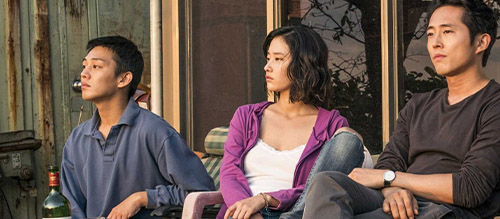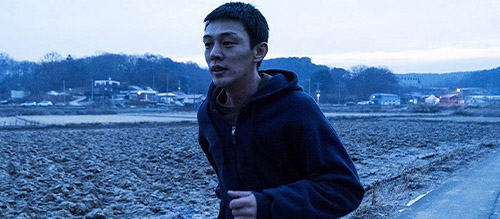‘Burning’ and Elusive Truth
This article was written exclusively for The Film Magazine by Jack Cameron.
It is not fair to say that cinema these days is just sequels and reboots. But, in an increasingly chaotic world, who can blame audiences for wanting to slip back into the arms of heroes they’ve known since childhood, to be retold the stories they already know they’ll love? While there’s no denying that films like these do very good box office, nostalgia is just not what it used to be.
Later this year Kenneth Branagh will return as Poirot, a character so well known he could be reduced to an accent and moustache and still be recognised. Beginning in the 1920s, Agatha Christie’s detective fiction was phenomenally successful. These were books that investigated humanity’s dark side, breaking away from the image of aristocratic purity and read by an audience who were still reeling from the horrors of war. Nowadays, to anyone who has ever read a Christie book, watched one of the many films, or just taken a sick day in front of the telly, these mysteries have already been solved.
Released in 2018, Burning is a masterpiece of mystery from Korean director Chang-Dong Lee, one that unlike the tales of Poirot does not conclude in a drawing room where the entire plot is revealed. In fact, most of the clues and even the murder itself are absent. Yet, despite denying the audience a conclusion, Burning is certifiably one of the most compelling and pertinent films of recent years.
To be clear, Burning is not like a David Lynch movie in which everything can be explained away as just a dream inside a painting that’s being filmed. There is a reading of Burning which does provide a very clear and definite conclusion. However, it must also be accepted that there is absolutely zero evidence for said conclusion. Burning does not deny the truth, but it makes it elusive. It does not challenge what we’re prepared to believe; it challenges why we believe it.
Based on a short story by Haruki Murakami, Lee, along with screenwriter Jungmi Oh, relocates the Japanese story to modern day South Korea. It follows Jong-su (Ah-In Yoo), a young man with aspirations to be a writer who must work on his father’s dilapidated farm while the latter awaits trial. Very early in the film, Jong-su meets the hypnotic Hae-mi (Jong-seo Jun), an ex-classmate. After a small date, Jong-su agrees to look after Hae-mi’s cat while she goes on a trip to Africa. Upon her return, Jong-su is surprised to find Hae-mi in the company of the dapper and enigmatic Ben (Steven Yeun). Soon a love-triangle begins with Jong-su struggling to keep up with his new ultra-rich, smooth-talking rival. As far as plot summaries go, there’s not much point in going any further; with each new scene the film kicks up a gear, seamlessly transitioning into new genres and effortlessly refusing to fully reveal itself. Instead, the film plunges headfirst down the rabbit hole.
Burning opens with a tracking shot of Jong-su on a delivery job. It opens on his truck, behind which he then appears, collects his package and makes his way down the street to his destination. The shot introduces key themes in the film, most notably its social realist look at wealth inequality in Korea. Despite working on a farm, Jong-su still has to take odd-jobs in order to get by. Lee is a poetic filmmaker, and as such nearly every shot (no matter how passive it may appear) is deliberate and packed with meaning that will echo throughout the film. Lee’s characters are often shunned by society, and his films are designed to give depth and complexity to outwardly simple people. His best films will never give a single definition of a character, but by the end, every line of dialogue will be bubbling with meaning. Put simply, there’s always more than meets the eye, and Burning uses this trick to establish a sense of mystery from the very beginning. It is crucial that Jong-su is initially covered by the truck: even though he is clearly the film’s protagonist, the audience will come to learn that there is something about this man that will always be obscured.
Hae-mi has a similar effect, but rather than there being something missing, there is a double meaning in nearly everything she does. When she’s introduced, Jong-su doesn’t recognise her because she’s had plastic surgery. She later reveals that he once called her ugly as a child. The two then start a tentative romance, except now there’s an uneasy feeling that settles on their relationship: is this a comment on the impossible standards women are held to, or some kind of elaborate revenge? The film’s genius is in how it presents very natural human behaviours but manages to make the motivations behind them seem eerie.
For example, Hae-mi has been practising pantomime. She expertly mimes peeling and eating a tangerine, claiming the trick is not in pretending that it’s real but “forgetting that it’s not there”. This becomes significant when Jong-su begins feeding Hae-mi’s cat, a cat that never appears. It may be that the cat doesn’t exist and Jong-su is the subject of a hoax, but he continues to feed it because he’s starting to fall in love. Love is one of the most instantly recognisable and empathetic human behaviours, but that doesn’t make it logical. Perhaps the best way for Jong-su to justify feeding an invisible cat, in the eyes of love, is to forget that it isn’t there.
Ben is arguably the most elusive and strange of all the characters. The audience may be naturally opposed to him, but there’s very little known about him. Who he is and how he makes his money are never explained. Instead, in the film’s most revelatory moment, Jong-su describes Ben as a ‘Gatsby’, the archetype of a rich man of mystery. There is an irony to our logic here if a man is more easily understood as a metaphor.
All three of these characters create an uncanny atmosphere throughout the film’s duration. An atmosphere that shows the limits of the audience’s knowledge and, in doing so, encourages them to look further. Many camera shots reflect this, often focusing on the foreground before slowly swapping to focus on the background; revealing more depth while it clouds over the original image.
Half-way through the film Hae-mi disappears. There are several explanations; Ben murdered her and burned the body in a greenhouse; she ran away from a world that never respected her. Whatever the reason, what clearly upsets Jong-su the most is that no one seems to care. When Hae-mi disappears, society forgets that she isn’t there.
There are conclusions that can be drawn from this film, but for every point the audience have, the film provides a counter point; for every interpretation there is another perspective. The film’s action is only the comprehensible tip of the iceberg. Its story simply asks the audience to recognise that even though it may not be understandable, there is always more beneath the surface. At one point Ben asks Jong-su what he’ll write about, and he explains that he’s not sure because to him ‘the world is a mystery’. This is not an admission of defeat, it’s proof that he’s not arrogant enough to claim he’s got it all figured out.
Burning was released in an age of hyper-information. There are so many explanations and perspectives for any given event that often it is easier to stick with what is easily understandable. Burning challenges this behaviour; a challenge which is beginning to appear in the mainstream as well. Take Rian Johnson’s Knives Out, for example. In a moment that lovingly homages the classic Poirot drawing room scene, Daniel Craig’s detective proudly reveals that the case isn’t round like a doughnut but actually it’s a ‘doughnut hole within a doughnut’s hole… and our doughnut is not whole at all!’
Burning confidently engages with truth’s elusive nature. While it presents one story, it contains several more. As difficult as it may be, it expects the audience to start thinking beyond what they already know.
Written by Jack Cameron
You can support Jack Cameron in the following places:
Twitter – @JackCam86118967
Contently – Jack Cameron




